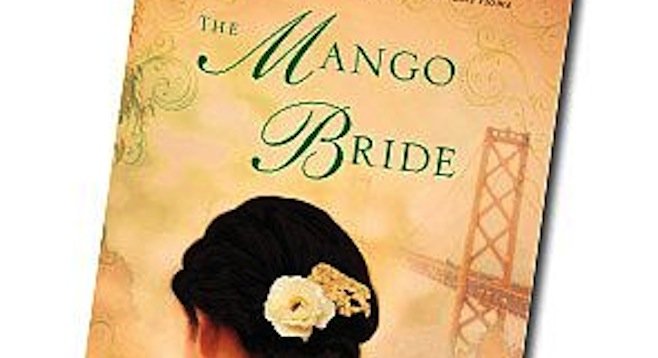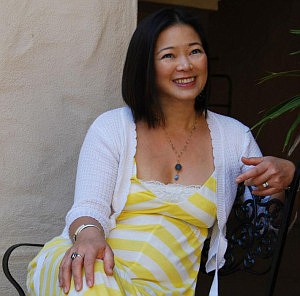 Facebook
Facebook
 X
X
 Instagram
Instagram
 TikTok
TikTok
 Youtube
Youtube

In our city, so close to an international border, a book that deals with the harsh realities of immigration should not struggle to grip San Diego’s collective attention. Where contemporary tales of immigration might look south to the Mexico-US border, The Mango Bride, by San Diego author Marivi Soliven, pulls characters across an ocean over the course of 341 pages. Amparo Guerrero and Beverley Obejas, the two women at the novel’s heart, both grew up in Manila, capital of the Philippines. The both end up in 1990’s Oakland through very different channels. Amparo leaves Manila in quasi-exile from her affluent family. Beverly flees her home country as a mail-order bride, hoping to rise above her family’s hereditary impoverishment.
For both women, loyalty to family, defined within the bounds of Filipino culture, is the unifying chord. It brings them together far from home, and as decades of family secrets come to light in the wake of violent tragedy, the effects of which cross countries and generations.

Manila, a city of 1.6 million people living in 15 square miles, is the third main character of The Mango Bride. I many ways, it’s as if Soliven closes her eyes, slips into her memories, and writes about the city she left behind when she moved to the US. Soliven came here as an adult, in the company of her husband as he pursued a graduate degree at UC Berkeley. Throughout the novel, the author shares vivid descriptions of Manila life, from its lowest slums (readers will learn about multi-generational families living in cemeteries) to its high-society galas. The island city, which vibrates with a life all its own, carries the full weight of customs and cultures foreign to contemporary American readers. The many differences, and some similarities, between “here” and “there” catch the book’s characters in a middle ground between two worlds.
Soliven, who came from a “buena familia,” a family of good social standing, writes at the end of the book that she had to work hard to fill out the details of Beverly Obejas’ character. The impoverished waitress lives a life of cramped quarters and daily hardship, eking out a life on the periphery of Manila society, sometimes surviving off the scraps of the social elite. Bringing her character to life was a major coup for the author, who painted a vivid picture of life below the poverty line in the third world.
Despite the fact that none of its characters ever set foot on San Diego streets, The Mango Bride is a product of San Diego. Soliven writes that the book “was conceived in one frenetic month during National Novel Writing Month 2008...and finally delivered after a two-year gestation period,” during which a cadre of local writers helped Soliven flesh out the story’s details. She doles out the credit to San Diego Writers Ink, a group that supports local writers with workshops and other resources, and to her workshop partners.
The author is no stranger to stories of Filipinos living in America. Her previous work, Suddenly Stateside, provides a collection of short essays on “Pinoy life in America.” The Mango Bride, Soliven’s first novel, combines Suddenly Stateside’s handling of the plights of Filipino emigrees with the narrative fiction of Spooky Mo, her collection of nine short stories centered on supernaturally powered Filipino women.
Knowledge of Filipino culture is not a prerequisite for reading The Mango Bride, nor is the book a political treatise on immigration issues. The search for kababayan (literally, “countrymen,” a term that comes up frequently in the novel) and family isn’t unique to Filipino people living in the US. It’s something that everyone experiences sooner or later, in some form or another. Even Americans, living in a city like San Diego where it sometimes seems like everyone comes from somewhere else, can identify with that.


In our city, so close to an international border, a book that deals with the harsh realities of immigration should not struggle to grip San Diego’s collective attention. Where contemporary tales of immigration might look south to the Mexico-US border, The Mango Bride, by San Diego author Marivi Soliven, pulls characters across an ocean over the course of 341 pages. Amparo Guerrero and Beverley Obejas, the two women at the novel’s heart, both grew up in Manila, capital of the Philippines. The both end up in 1990’s Oakland through very different channels. Amparo leaves Manila in quasi-exile from her affluent family. Beverly flees her home country as a mail-order bride, hoping to rise above her family’s hereditary impoverishment.
For both women, loyalty to family, defined within the bounds of Filipino culture, is the unifying chord. It brings them together far from home, and as decades of family secrets come to light in the wake of violent tragedy, the effects of which cross countries and generations.

Manila, a city of 1.6 million people living in 15 square miles, is the third main character of The Mango Bride. I many ways, it’s as if Soliven closes her eyes, slips into her memories, and writes about the city she left behind when she moved to the US. Soliven came here as an adult, in the company of her husband as he pursued a graduate degree at UC Berkeley. Throughout the novel, the author shares vivid descriptions of Manila life, from its lowest slums (readers will learn about multi-generational families living in cemeteries) to its high-society galas. The island city, which vibrates with a life all its own, carries the full weight of customs and cultures foreign to contemporary American readers. The many differences, and some similarities, between “here” and “there” catch the book’s characters in a middle ground between two worlds.
Soliven, who came from a “buena familia,” a family of good social standing, writes at the end of the book that she had to work hard to fill out the details of Beverly Obejas’ character. The impoverished waitress lives a life of cramped quarters and daily hardship, eking out a life on the periphery of Manila society, sometimes surviving off the scraps of the social elite. Bringing her character to life was a major coup for the author, who painted a vivid picture of life below the poverty line in the third world.
Despite the fact that none of its characters ever set foot on San Diego streets, The Mango Bride is a product of San Diego. Soliven writes that the book “was conceived in one frenetic month during National Novel Writing Month 2008...and finally delivered after a two-year gestation period,” during which a cadre of local writers helped Soliven flesh out the story’s details. She doles out the credit to San Diego Writers Ink, a group that supports local writers with workshops and other resources, and to her workshop partners.
The author is no stranger to stories of Filipinos living in America. Her previous work, Suddenly Stateside, provides a collection of short essays on “Pinoy life in America.” The Mango Bride, Soliven’s first novel, combines Suddenly Stateside’s handling of the plights of Filipino emigrees with the narrative fiction of Spooky Mo, her collection of nine short stories centered on supernaturally powered Filipino women.
Knowledge of Filipino culture is not a prerequisite for reading The Mango Bride, nor is the book a political treatise on immigration issues. The search for kababayan (literally, “countrymen,” a term that comes up frequently in the novel) and family isn’t unique to Filipino people living in the US. It’s something that everyone experiences sooner or later, in some form or another. Even Americans, living in a city like San Diego where it sometimes seems like everyone comes from somewhere else, can identify with that.
Comments